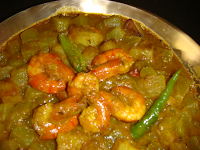Ingredients for making "Fish-Folder"
- For the Pan Cake Batter:
- Flour 1 Cup
- Egg 1 no.
- Milk 1/2 Cup
- Pinch of Baking Powder
- Pinch of Salt
- Refined oil
- For the Pan Cake Filling
- Fish (Rui/ Katla) 200 gms. marinated with a pinch of salt and turmeric powder.
- Grated Carrot 4tbsp
- 1 Potato (boiled& mashed)
- Finely Chopped Onion 4tbsp
- Finely Chopped Garlic 1tsp
- Grated Ginger 1tsp
- Lemon juice
- Finely Chopped Coriander
- Finely Chopped Green Chillies
- Garam Masala Powder 1/2 tsp
- Ghee 1tsp
- Mustard oil 2 tsp
- Sugar 1tsp
Boil the marinated fish with just the right quantity of water, till there is no more water left in the vessel. De-bone the fish using your hands. Add 2-3 drops of lemon juice into the fish and keep aside. Fry the onions in mustard oil till golden brown in a wok. Add the garlic, the ginger, the green chillies, and then fry for 5 minutes. Now add the finely chopped coriander leaves and the grated carrot, and finally the boiled and mashed potato.. Finally Add the de-boned fish. Saute for 5 minutes. Add 1 tsp sugar, salt (to taste), ghee and garam masala powder. Spread the mixture on the wok so that it gets completely dried.
Now for the pancake, heat a nonstick frying pan and grease it with 1/2 tsp refined oil. Pour the pan cake batter with the help of a serving spoon and spread uniformly in a low flame. Turn upside down. Now place the fish filling inside the pan cake and roll it like a "Patisapta". Serve with "Cheese Yoghurt Sauce"










































 |
|